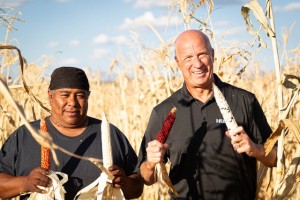Tomorrow is National Ag Day! Just like Huma, Inc., National Ag Day is enjoying its golden anniversary. The day is dedicated to celebrating and raising awareness for how our food, fiber (and energy) is produced. This year’s theme is “Growing a Climate for Tomorrow.” Agriculture is the USA’s largest employer, responsible for 23 million jobs – with about 2 million being actual farmers. While the number of farmers continues to decline, the job market in agriculture is booming. USDA expects to see almost 58,000 job openings per year for graduates with a bachelor’s degree or higher. The strongest job market is expected for plant scientists, food scientists, sustainable biomaterials specialists, water resources scientists and engineers, precision agriculture specialists, and farm-animal veterinarians. While Ag Day is officially celebrated on March 21, agriculture is the one industry we celebrate every day, three times a day.
Few images depict farm life and the miracle of life like a newborn calf. I enjoyed witnessing many of these images while driving by ranches and pastures this past weekend, as the calving season is now upon us. Spring is when about ¾ of all calves are born, as it provides ranchers with several advantages. Spring births allow you to wean and market calves prior to winter and avoid higher feeding costs. A momma cow’s nutritional requirements are lowest at mid-gestation and highest during peak lactation, making spring births optimal as pastures begin to green up and less hay is required for feed. Producers must frequently check their herds during calving season, as newborn calves are highly susceptible to chills and hypothermia, particularly right after birth when they are still wet and may be born in cold, wet, or windy conditions. Sometimes, calves are lodged inside their mother’s birth canal, and will literally need to be pulled from its mother (not a fun job, I can assure you). A newborn calf needs the colostrum – mother’s milk – for essential antibodies, and a young calf best absorbs those antibodies if it nurses within the early hours of its life. If a newborn calf is not nursing on its own, substitute colostrum from another cow or a dried source can be used as a supplement. In these situations, or on the rare occasion when a cow rejects her calf, the calf must be bottle-fed. As the name implies, this involves using a giant baby bottle to feed the calf 2-3 times per day. This may initially involve forcing it in the calf’s mouth. Speaking from plenty of hands-on experience, this process requires lots of patience, but in a few days, the calves become receptive.
Stimulating news out of Congress last week: the Plant Biostimulant Act of 2023 was introduced in both the US Senate and House. The bipartisan legislation – sponsored by lawmakers from California and Indiana – seeks to clarify the definition of biostimulants, which will help advance both innovation and adoption of these critical growth managers. Biostimulants have long been niche products, used by growers to mitigate abiotic stress or as a secret sauce for contest-winning yield. Now the products are going mainstream, evidenced by double-digit annual sales growth. Humic and fulvic acids are popular sources of biostimulants. In addition to providing a consistent yield bump and sound ROI, these natural substances offer several environmental benefits while playing a key role in advancing soil health and regenerative ag practices.
America’s long-standing claim as the world’s top corn exporter is in jeopardy. If projections hold, Brazil will assume that role by year’s end. Holding this distinction requires two critical factors: production and buyers. The latter is coming from the world’s top importer of corn. China, which buys over 13% of all corn imports, is now the top destination for Brazilian-grown maize. China had relied primarily on the USA and Ukraine for corn, but the world’s most populous country is looking to manage the disruption caused by the Russia-Ukraine war and lessen reliance on the USA. The strong US dollar makes alternative sources more attractive for foreign buyers, and one can’t overlook the current Sino-American tensions as also playing a role.
On the production side, Brazil’s export boom is driven by the practice of safrina. Due to the favorable tropical climate, many Brazilian farmers hold the unique ability to grow multiple full-season crops per year. The Portuguese term for “little harvest”, safrina is Brazil’s second corn crop, planted in January/February immediately after the soybean harvest. In recent years, the little harvest has eclipsed the first, now accounting for three-quarters of the nation’s corn output. In some northern areas, a third corn crop is grown. Brazilian corn acreage has risen rapidly, 70% in the past two decades, as has its yield (50% increase during the past 15 years). Yet their average corn yield is still about half that of US farmers.
Related Posts

This Week in Ag #2
Are we looking at a fertilizer shortage? Guess it depends on your definition. The availability of fertilizer isn’t a major concern in the US. It really wasn’t last year, either. As a good friend (who I consider to be among the best farmers in the country) told me last winter, “you can get it, it’s

This Week in Ag #41
This is American agriculture’s big week – Thanksgiving! Our celebration of food takes center stage on family dining tables from sea to shining sea. Not only do we honor the 1% who currently feed us, we also reflect upon the many contributions of the original American agriculturalists, our Native Americans. For starters, they saved the Pilgrims from starvation during their first years in the New World. The Wamponoag tribe utilized their famous “Three Sisters” cropping practice: corn, beans and squash.

The Right Stuff for Soils and Plants
By Mojtaba Zaifnejad, PhD When applied fertilizers benefit soil health and plant growth, and are readily available to them, it is said that they are bioavailable. The extent of bioavailability of nutrients and fertilizers applied to soil and plants determines their effectiveness in improving soil health and crop yield. In addition to the 4Rs approach,



